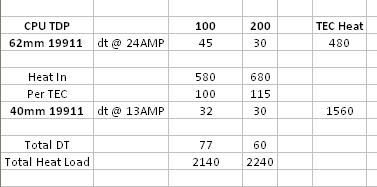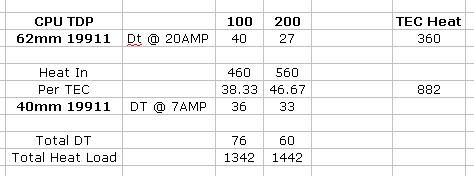Hi guys and in particular Pneumonic.
It's great to see someone so excited by TECs as Pneumonic
I've Sent your block today so it should be there in a week id say ..
i've read through this tread and i'd like to pic up one one of the graphics you made.
Though this is a great graphic it doesn't seem to be anywhere near the truth.
It seems that you are excluding the reduction of QMAX and dTMAX when the hot side of the lower direct direct die block is cools below 300Kelvin
Adding these factors in would reduce the estimated loaded delta.
Probably the biggest problem with this graphic is your not accounting for a change in the hot to cold side delta once you apply a load to it.
IE a 300 watt QMax TEC ran at Umax and Imax with a hot side of 300k will ether move 0 watts to dTmax (69c) or move 300 watts to a delta of 0
For the same given input power as you increase the load applied to the cold side, the resulting delta will reduce as you increase the load.
In your graphic you are implying that the above is not a factor and you seem to have the deltas between the hot and the cold sides of the TEC's at a constant ish as you increase the load.
sooooo unfortunately your expectations may not be realized
Anyway keep up the great work and i look forward to your coming posts




 my 1200 watt first impression was a bit off.. hence why I went through the exercise of 'doing' it properly on the maths front..
my 1200 watt first impression was a bit off.. hence why I went through the exercise of 'doing' it properly on the maths front.. 

